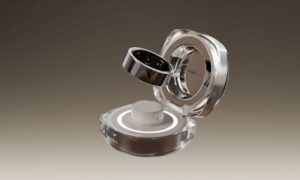The wearable technology industry has made huge strides in recent years, and one of the most exciting innovations is the smart ring, which could partially replace the fitness bracelet or smartwatch from the market. As we gravitate toward healthier lifestyles, smart rings have become a valuable tool for monitoring well-being. These compact devices perform many of the functions of a smartwatch—such as tracking sleep, activity, and overall health—while doubling as a stylish accessory worn on your finger. Additionally, smart rings often boast longer battery life compared to smartwatches, allowing users to spend less time charging and more time enjoying the benefits of the technology.
As many have noticed, this year Samsung unveiled a new type of device at its latest Unpacked event on July 10—the Samsung Galaxy Ring. This marks a significant shift in the smart ring landscape. Naturally, we couldn’t miss the opportunity to delve into this innovation and have prepared a comprehensive review: Samsung Galaxy Ring review.
Currently, the smart ring market is dominated by specialists like Oura and Ultrahuman. However, major brands are now turning their attention to these devices, integrating rings into their existing ecosystems. This shift potentially marks a transition from a niche segment of the smart ring market to a significant sector within wearable technology.
In the latest complete year of data, 2023, IDC recorded global smart ring sales at 880,000 units, which is a notable achievement. IDC forecasts that this figure will rise to 1.7 million units in 2024 and 3.2 million by 2028. For comparison, the total global sales of smartwatches in 2023 amounted to approximately 161 million devices.
This highlights the greater maturity of the smartwatch market and the lengthening replacement cycles as updates become increasingly incremental. Thus, for now, smart rings will remain a small but rapidly growing segment of the wearables market.
Initial reviews of the new Galaxy Ring indicate moderate interest, as consumers seem to appreciate the innovative form factor it offers. The ring’s design has a clear advantage—being sleeker and less obtrusive than a smartwatch, which is particularly significant for sleep tracking. Many smartwatch users dislike wearing a watch to bed but don’t mind keeping a ring on. There’s also a subset of consumers, especially those with smaller wrists, who are not fond of bulky smartwatches like those from Apple and Samsung. While some brands, such as Garmin, cater to this audience with more delicate designs like the Lily series, the ring format presents another compelling option.
Industry discussions reveal that many major players in the wearable tech market are closely monitoring the sales performance of the Samsung Ring. They are actively exploring the potential of developing their own smart rings, signaling growing interest in this emerging segment.
Unfortunately for the wearable tech market as a whole, smart rings seem to directly compete with smartwatches, as many of their features overlap. For instance, the Galaxy Ring offers sleep tracking, heart rate monitoring, activity tracking, and health monitoring — functionalities already present in Samsung’s Galaxy Watch lineup. While Samsung emphasizes the complementary use of both devices, stating, “Using the Galaxy Ring with a Galaxy Watch maximizes their combined health features and extends the ring’s battery life,” this overlap raises questions about differentiation. When comparing prices, the Galaxy Ring is currently priced at approximately $500. Its main competitor, the Oura Ring 4, starts at $349 but requires a $5.99 monthly subscription, making the value proposition another critical consideration for consumers.
Thus, it seems inevitable that, in the medium and long term, smart rings will gradually eat into the market share of smartwatches in the wearable tech segment. How soon this shift will occur remains to be seen, but undoubtedly, there will be individuals who might not consider buying a smartwatch yet would be drawn to the prospect of owning a smart ring.
Smart rings are a type of device that has the potential to thrive in the coming years, and the degree of this success will depend on how many major players enter the market and whether the overall positive reception and consumer interest continue. However, as “smart” rings flourish, we will likely see these manufacturers somewhat cannibalizing their own market share. As their smart ring sales grow, it’s likely that their smartwatch sales will decline. Well, time, like technology, doesn’t stand still—let’s make way for innovation!





































